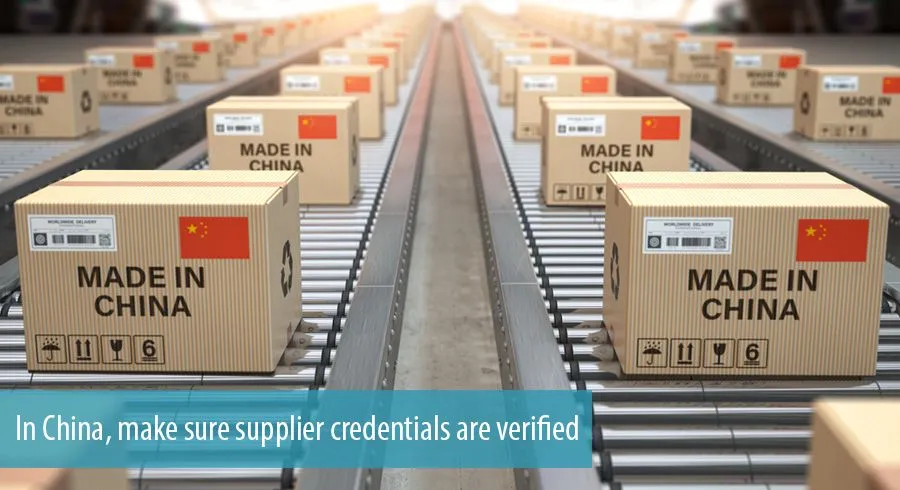Outsourcing Procurement to China — The definitive, actionable guide for procurement teams

China remains the fastest path to breadth of materials and competitive unit cost — but success depends on the model (in-house / hybrid / full managed) and rigorous controls.
Treat a sourcing partner as a supplier: run the vetting script, demand registration + audit evidence, pilot them on a paid small order.
Use a three-tool kit to de-risk: RFP + Supplier Scorecard + QC SOP (examples included below).
Make ESG non-negotiable: require verifiable certificates, chain-of-custody documents and contractual remediation steps.
Track OTIF, PPM, ESG score and landed-cost variance; use a 60–90 day pilot with explicit acceptance thresholds.
Pick the model by two variables: volume and complexity / risk.
Low complexity, high volume → Direct mill + procurement managed in-house. Best margin but needs capacity to manage suppliers, QC and logistics.
Medium complexity, medium volume → Hybrid (strategy in-house, execution via agent). Good for brands who want control but lack China footprint.
High complexity or high ESG/regulatory risk → Managed procurement provider (MSP). Pay for end-to-end service: sourcing, QC, testing, traceability and reporting.
Low volume, speed critical → Local sourcing agent / market hubs. Use Guangzhou/Humen for fast sampling, then scale to Shaoxing/Shengze for volume.
Use this simple flow: if you cannot staff a China-based person and you need ESG traceability, choose MSP or vetted sourcing agent. If you have a China team and large volume, go direct to mills.

Treat agents like suppliers. Ask them to prove these items before you pay any meaningful fees.
Minimum vetting script (ask in writing; follow-up with documents):
Registered business name & registration number — provide scan of the business license and tax registration.
Bank details and corporate bank statement (last 3 months) — confirm routing.
Three current client references (name, company, contact) for similar categories. Contact at least two.
Recent on-site evidence — time-stamped photos / 1–2 short factory walkthrough videos within the last 90 days.
Audits & certifications they manage (SMETA, BSCI, GOTS, GRS, Oeko-Tex) — provide certificate numbers and scanned reports.
Service scope & SLA example — written sample showing responsibilities and KPIs they guarantee.
Fee structure — % of FOB, fixed per-PO, retainer; request sample invoice and a T&Cs sheet.
Sample handling & storage policy — how they label, photograph, insure, and store samples.
Insurance & indemnity — confirmation of professional indemnity/cargo insurance options.
Pilot proposal — a written 60–90 day pilot plan with milestones & success metrics.
Red flags: cash-only requests, refusal to share registration, unverifiable references, unwillingness for a short paid pilot.
Use this field list as a copy/paste RFP form for suppliers or agents.
RFP — required fields
Buyer name, contact & legal entity.
Product name / SKU / category.
Technical spec: composition (%), GSM, weave/knit type, width, finish.
Tolerances: weight ±X%, width ±X cm, color tolerance (∆E).
Test standards: list required lab tests + standards (e.g., ISO, AATCC, ASTM).
Samples requested: swatches, lab-dip, strike-off, PP sample. Deadlines for each.
Packaging & labeling requirements (units per roll, inner/outer packaging, palletization).
MOQ & price tiers (specify FOB/EXW).
Payment terms (deposit %, payment instrument).
Lead time: sample / bulk manufacturing / lead time tolerance.
ESG & compliance: list required certificates (GOTS, GRS, SMETA, etc.), frequency of audits, remediation clause.

AQL & inspection: specify AQL level (e.g., General 2.5 / Critical 0).
Warranty & defect policy: rework timeline, credit for defects, replacement policy.
IP & confidentiality: NDA required? confirm IP protections.
Confidentiality & non-circumvention clause.
Contact for clarifications and submission deadline.
Embed a short acceptance statement at the bottom: “By signing, supplier confirms all information is truthful and consents to third-party audits.”
Set weights to reflect your priorities (example below is balanced toward quality + ESG).
Weights
Quality: 30%
OTIF (On-time in full): 20%
Price competitiveness: 15%
ESG / compliance: 20%
Communication & responsiveness: 10%
Flexibility (MOQ, color runs): 5%
Example scores (two suppliers)
| Criteria | Weight | Supplier A | Supplier B |
|---|---|---|---|
| Quality | 30% | 78 | 84 |
| OTIF | 20% | 85 | 70 |
| Price | 15% | 80 | 88 |
| ESG | 20% | 60 | 95 |
| Communication | 10% | 90 | 75 |
| Flexibility | 5% | 70 | 65 |
| Weighted score calculation: |
Supplier A = 78×0.30 + 85×0.20 + 80×0.15 + 60×0.20 + 90×0.10 + 70×0.05 = 76.90.
Supplier B = 84×0.30 + 70×0.20 + 88×0.15 + 95×0.20 + 75×0.10 + 65×0.05 = 82.15.
Use the score to shortlist top 2–3 suppliers for pilot orders.
Define sample types and the minimum inspection cadence.
Sample hierarchy
Swatch/hand sample — tactile test.
Lab-dip / color match — required for dyed products.
Strike-off / print test — for printed or pattern finishes.
Pre-production (PP) sample — must match production specifications.
Pre-shipment sample — taken from actual bulk run.
QC checkpoints
Incoming raw material check — verify composition, GSM, width, roll defects.
In-process inspection — at 30%, 60%, 90% production. Document corrective actions.
Final AQL inspection — use ISO 2859 / AQL sampling; for critical items adopt 1.5% AQL.
Lab testing — colorfastness, shrinkage, pilling, composition verification (FTIR for synthetics).
Packing & labeling inspection — ensure packing specs met.
Minimum deliverables from inspection
Photographic evidence (roll-level), inspection report with defect categories, lab reports (if any), pre-shipment sample retained for reference.
ESG is not marketing — it’s contractual and auditable. Require documentary proof and a chain-of-custody.

Operational steps
Specify certificates in the RFP: demand certificate numbers + issue date + certifier. Required examples: GOTS for organic; GRS for recycled content; Oeko-Tex for harmful substances.
Verify certificate: go to certifier’s public database, enter certificate number and confirm facility scope and expiration. If a database lookup is unavailable, request a scanned certificate and lab raw-material invoices that map to lot numbers.
Request audit reports: require an up-to-date SMETA / BSCI / third-party social audit within the last 18 months. Ask for CAP (corrective action plan) and evidence of closure.
Chain-of-custody: require mill invoices showing raw material batch numbers, transport documents and a statement of custody from each stage (spinner → mill → dyehouse → converter).
Third-party verification: use accredited labs for test reports and use independent auditors (QIMA, SGS, Bureau Veritas) for spot checks.
Contractual levers: include ESG KPIs and remediation timelines; allow buyer the right to suspend payment or terminate for critical non-compliance.
Practical checklist for contract ESG clause
Required certificates (list + numbers).
Audit frequency & acceptable audit bodies.
CAP timeline (e.g., corrective actions must be submitted within 10 business days).
Financial holdbacks for unresolved critical findings.
Right to conduct unannounced inspections.
Run a paid pilot to validate execution before scaling.
Pilot scope (example)
Goal: validate quality, OTIF, and ESG evidence for one SKU at MOQ-scale (e.g., 1,200 m).
Milestones:
Day 0: Sign pilot PO, agent confirms sample plan.
Day 7–14: Receive lab-dip & PP sample; approve or require one revision.
Day 15–45: Production run; in-process inspections at 30/60/90%.
Day 46–60: Final AQL inspection, lab tests, packing verification.
Day 60–75: Shipment and landed-cost assessment.
Day 75–90: Pilot review & go/no-go decision.
Pilot success thresholds (example)
OTIF ≥ 90% for pilot deliveries.
PPM ≤ 500 defects per million on final inspection.
Required certificates verified and audit CAPs closed within 30 days.
Landed cost within X% of target (define X in RFP).
If thresholds met, escalate to a 3–6 month scaling contract.

Use a spreadsheet in real cases. Example (illustrative numbers):
Order: 1,200 m @ $3.20/m → goods value = 1,200 × 3.20 = $3,840.00.
Inland consolidation: $120.00
Ocean freight share: $200.00
Insurance: $10.00
Import duty (5% of FOB): 0.05 × 3,840.00 = $192.00
Customs clearance & local trucking: $150.00
QC & lab tests: $120.00
Total landed cost = 3,840 + 120 + 200 + 10 + 192 + 150 + 120 = $4,632.00
Per metre = 4,632.00 ÷ 1,200 = $3.86 / m
Rule: always run three scenarios: air sample, LCL small batch, FCL full container — and confirm duty rules for your destination (duty basis can be CIF or different by country).
Delivery SLA (example)
Supplier will deliver shipments in accordance with agreed lead time ±5%. Late delivery beyond 7 calendar days is subjected to a penalty equal to 0.5% of PO value per week, capped at 3% of PO value.
Quality SLA (example)
Products must meet agreed AQL and pass all agreed lab tests. Failure of AQL requires supplier to rework or replace product at supplier cost within 15 calendar days; repeated failures entitle buyer to source replacements at supplier cost plus 10% administration charge.
ESG clause (example)
Supplier must maintain certifications listed in Annex A and supply audit reports upon request. Critical non-conformities must be addressed with CAP submitted within 7 days and remedied within 45 days. Buyer may suspend orders or withhold up to 10% of invoice pending remedy.
IP protection (example)
Supplier shall not manufacture products for third parties using buyer designs for 24 months post last shipment. Breach entitles buyer to injunctive relief and liquidated damages equal to 150% of net profit from infringing goods.
OTIF % (weekly / monthly) — target 95%+.
PPM / defect rate (per shipment) — initial target <500; mature target <100.
ESG compliance rate (% suppliers with required certs) — monthly.
Landed-cost variance (%) — monthly.
CAP closure time (days) — target median <30 days.
Supplier concentration (%) — % spend with top 3 suppliers; aim <40% if risk-averse.
Cadence
Weekly ops call for open POs and immediate issues.
Monthly performance review with scorecard and action items.
Quarterly governance with strategic KPIs and supplier development planning.
Order aggregation: use an agent to combine multiple small orders across brands and split at packing stage.
Remnant & roll purchasing: negotiate for end-of-rolls or color-variants.
Short-run finishing: get mills to do core processing, finish small lots at a local converter.
Accept higher prototype unit price for speed and confirm a scaled price for volume runs.

Case A — Brand scales a pilot to 6-figure annual volume
Problem: D2C brand struggled with inconsistent dye lots and late shipping.
Action: ran 60-day pilot with two mills and an MSP; required lab-dip approval and pre-shipment AQL.
Result: OTIF rose from 70% to 94% over 3 months; color variance reduced to within ∆E ≤ 1.5; landed cost within 3% of target.
Case B — ESG remediation saved a relationship
Problem: audit revealed forced-labour risk in supplier input chain.
Action: supplier submitted CAP, agent stepped in to re-source raw cotton with traceable invoices; third-party re-audit in 45 days.
Result: CAP closed, buyer retained supplier under stricter oversight, avoided full re-sourcing.
1) What shipment documents should I expect from my supplier before customs release?
Ask for the commercial invoice, packing list, bill of lading (or AWB), certificate of origin, and any product-specific certificates (e.g., fumigation, phytosanitary, or conformity certificates). For bonded or special regimes you may also need the export declaration and customs release notice. Get digital copies early so your customs broker can pre-file.
2) How can I safely share design files and tech packs with overseas factories?
Share low-resolution or watermarked files for initial quoting. Use an encrypted file transfer service, limit access via time-bound links, and track downloads. Register key designs where relevant and include a narrow, practical NDA that limits file use and forbids subcontracting without consent.
3) Which insurance policies should a buyer consider when importing from China?
At minimum: marine/cargo insurance (goods in transit), product liability insurance (for the market), and buyer’s credit insurance for receivables risk if you finance local distributors. Consider manufacturer’s warranty insurance if the supplier won’t accept replacement liability. Match cover limits to shipment value and Incoterm.
4) Quick checks to assess a supplier’s financial stability without a deep audit
Request a recent bank reference, look up paid-up capital on the company registry, ask for last 2 years’ turnover ranges (or trade references), and use local credit reporting services or trade-finance partners to flag late-pay patterns. Sudden ownership changes or frequent factory relocations are red flags.
5) What operational steps are needed to onboard a new Chinese supplier (non-technical checklist)?
Create an onboarding packet that includes: master data entry (legal name, bank info), communication cadence, escalation contacts, required labeling/packaging specs, approved labs and compliance contacts, and a first-order acceptance checklist signed by both parties. Run a one-page “first PO” walkthrough call to lock expectations.
6) When should you retain local legal counsel in China?
Engage counsel before signing long-form contracts that involve IP, exclusivity, equity, or large advance payments; when you need enforceable warranty or escrow arrangements; or if you plan to set up local entities. Use counsel for jurisdiction selection and to vet arbitration clauses.
7) How can you protect your business from seasonal capacity shortfalls in China?
Negotiate rolling capacity bookings with suppliers, maintain a small safety stock, pre-book critical dye slots or finishing capacity before peak season, and qualify 1–2 backup vendors in lower-season regions to absorb overflow.
8) What hidden or recurring costs do teams often overlook when outsourcing procurement?
Look beyond unit price: demurrage/detention fees from missed free time, rework or rewash costs for off-spec batches, certification renewal fees, translation and legal review costs, and incremental freight surcharges during peak season. Model these as a recurring overhead in your TCO.
9) Practical packaging rules that prevent damage and claims disputes
Standardize: inner pack counts, box strength (ECT rating), pallet configuration, humidity-resistant liners for textiles, clear barcodes and carton numbering, and one photographer-verified pallet photo record per shipment. Include packetized spare parts or swatch samples inside to speed claim validation.
10) How do you expand from a single SKU to a multi-SKU program without chaos?
Introduce modular specifications (shared fabric base, standard trims), a central PLM or specification repository, a staging pilot for each new SKU family, and a supplier split that assigns primary/secondary responsibilities for families rather than individual SKUs.
11) What dispute-resolution routes work best for international procurement issues?
For cross-border enforceability, mediation followed by arbitration (Hong Kong CIETAC, SIAC, ICC) is standard. Choose a neutral seat and an enforceable award jurisdiction. Keep escalation steps and interim remedies (e.g., independent testing) in the contract to avoid immediate litigation.
12) How should I evaluate a supplier’s readiness for digital integration (EDI/portal/API)?
Check for a published IT contact, ask if they can exchange CSV/EDI purchase orders and ASN files, confirm ERP compatibility (e.g., SAP/Oracle connectors), and run a short data-exchange pilot (one PO → one ASN). Prioritize suppliers that can provide automated shipment notices and invoice data to reduce manual reconciliation.
Contact us
Call Us: +86 193 7668 8822
Email:[email protected]
Add: Building B, No.2, He Er Er Road, Dawangshan Community, Shajing Street, Bao'an District, Shenzhen, China